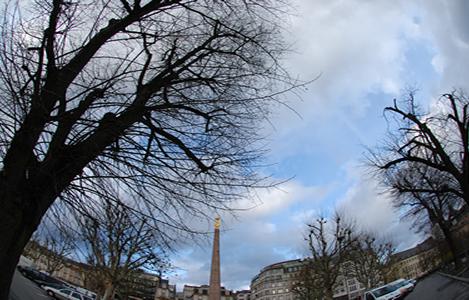|
Luxe Life

Photograph
by Preeti Verma Lal
“The machine is finished. It go no further….” The train driver knitted his eyebrows, puckered his nose and announced, his throaty inflexion adding to curmurring of the dying engine. The train had hissed its last breath somewhere between Frankfurt and Luxembourg. “You go to next stop Trier, Germany’s oldest city. Or run to the next platform, that red train goes to Luxembourg,” adjusting his black cap the driver was lending information. I looked at my Eurail Global Pass – the 6x3 inch beige pass with my name in sans serif could take me to 23 countries for a lark, but before I could throw a dart on the map, I remembered the dainty girl with a pearl earring, the brusque bearded Shylock and the menacing vampires who once walked the cobbled pathways of Luxembourg, the world’s 20 th smallest country with the world’s highest per capita income. A sacred relic was waiting next door in Trier’s cathedral, but that frosty morning I spurned piety and lickety-split hopped onto the red train to Luxembourg. It was pizzazz Hollywood-style.
“Squint your eye. Look beyond the bridge. There’s the blue roof. The gleaming blue. That is the restaurant where Scarlett Johansson celebrated her 18 th birthday.” I was leaning over Corniche, the most beautiful balcony in Europe, and peering hard towards where guide Steve Lyons was pointing. In Luxembourg I was squinting stiff, but all I could see was the Holy Ghost Citadel and the lower town of Grund. Ah! Scarlett. The one who wore a peasant frock and became the muse of paint-spattered, smocked Colin Firth in The Girl with the Peal Earrings. So, she was here, I thought aloud. “Oh, many more. You have Bollywood, we have Luxywood, where a million movies have been made. It is a film city,” Lyons was dropping Hollywood names and I was still struggling to locate the blue roof.
Failing to find any blue roof against the azure sky, I squinted again, but this time for the Bock Promontory that Siegfried, Count of Ardenne, acquired in 963 in barter with the Abbey of St Maximin in Trier. This ledge on which the Count was to set up his castle
is no mundane rock – it was here that the history of Luxembourg began, where the crypts were detailed, Bock Casemates (underground tunnels) and 40,000 square metres of bombproof rooms were hewn into the rock, where the first market sprung and where the Alzette river meandered languidly. So strategic was the Grand Duchy of Luxembourg on the European chessboard and so fortified was the city that it earned the epithet the Gibraltar of the North for its mighty emplacements. I was busy counting the 37 towers and 15 gates of the Wenzel Wall when Lyons interrupted my mathematics with a glam vignette from The Merchant of Venice.
No, not the one that Shakespeare wrote in iambic pentameters, but the Shylock that Al Pacino essayed with glued beard, burgundy robe and a menacing scowl in the Michael Radford Hollywood version of the Shakespearean drama that was shot in Luxembourg. “ Venice was recreated on the moat and the gondola scene was the talk of the town for months to come,” Lyons, on that frosty day, was adding histrionics to the rather romantic tale of the country that sprawls on a meagre 2,486 sq. kms, its Old City listed as a UNESCO World Heritage Site.
My tryst with cinema was to end no sooner in Luxembourg which was once toasted more for its true textbook example of military architecture than for the Hollywood stars that daubed make-up and spewed dialogues under harsh arclights. Much before John Malkovich baulked at the shadows of vampire in the film of the same name, it was a ghoulish concrete bust that hung taut over the city’s oldest cinema which had a royal visitor – Charlotte, the Grand Duchess of Luxembourg, the country’s sole female ruler who often tip-toed on the narrow cobbled street in tulle gown and her little children in tow.
That day as the warm afternoon melded into a nippy evening, the city’s main shopping street shimmered with neon lights and silver mannequins, the rich walking into ritzy shops, gleefully emptying their wallets for a pricey mink and a glittering bauble. In the city with the world’s highest per capita income, glam is the way to be. Luxembourg was getting ready to sleep, but I still had to see the granite statue of Grand Duke William II of Orange Nassau looking drop-dead on a stallion, the flowers on the wreath of the Golden Lady at Gelle Fra Memorial and the beatific angels as door knobs on 400-year old Cathedral of Blessed Virgin.
Suddenly, rain thundered down and I found shelter in the mahogany pew of the Blessed Virgin. Hundreds of orange candles etched with Ave Maria were flickering by the altar, their iridescence lending glow to the beautifully painted glass windows. I closed my eyes and said: Du weess, datt ech midd sinn (“You know that I tired am”). No, I had not turned into a verb-incorrect oaf. In Luxembourgish, the country’s national language, verb gets a little misplaced. But in Luxembourg it is not about verb, it is what the anonymous poet wrote in Iolande, The Tale of the Duchy of Luxembourg, about “themes of joy”.
Published
in The Indian Express, 2009 |

